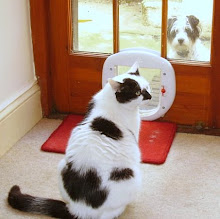A quick update on the boating saga. We now have an inflatable dinghy (a large one - he never does this by halves), a huge outboard engine and a happy husband. At least, he will be when it's warm enough to blow the thing up and actually get in the water with it.
And on matters nautical, here's an interview with two lighthouse keepers. Not a job I would enjoy, but luckily they did. In Feb's Cornwall Today.
“YOUR LIFE IS YOUR BUNK” -
A tale of two lighthouse keepers
“I'd do it all over again!” says Gordon Partridge. “It was a unique way of life, not just a career. There's nothing else like it.” Gordon, 61, worked on 22 lighthouses during his time as a lighthouse keeper before being made redundant in 1996 because all UK lighthouses became automated by 1988. “I served at Les Casquets (7 miles West of Alderney) for 6 years and was the last Keeper "up the ladder" and into the helicopter,” he says proudly.
“I came from a fishing family from Brixham,” he continues, “and after fishing I wanted something more settled with more leave. I'd always been intrigued by lighthouses from a sea perspective, so I applied to Trinity House.”
There he found that the most important qualification was not a degree, but having the right personality. “Self-reliance was paramount,” he says firmly. On acceptance, he went to the Trinity House training school where he was taught everything he would need to know about life in a lighthouse. “We learned electrics, mechanics, radio work, First Aid at Sea (including giving injections of morphine etc.), Morse code, rope work, fire fighting and evacuation, how to make a lighthouse work and how to maintain it.” He laughs. “We even learned how to make bread!”
The training gave him some idea of the duties required, although there were never less than 3 men on a lighthouse at any given time. “There was usually a principal keeper and two assistants. Sometimes a 4th would join as a Supernumerary Assistant Keeper (SAK). As a SAK you travelled to any lighthouse you were sent, relieving duties and that's when you got the most variety of lighthouses. I went to Wolf Rock, Longships, Bishop Rock - all the Western Rocks as they were known. And served the Bishop twice.”
The shift pattern was as follows: “On Day 1 we worked 4am-midday, then off. On from 8pm-midnight. Day 2 was 1200-2000, 4 hours off then back on at 0000-0400,” says Gordon. “The next day we had 24 hours off, but the person who was off was usually cook of the day.” They would stay on the lighthouse for 2 months but this was later reduced to one month, with 1 month off.
Setting off for a month's stay, it was important to take everything with you, including food, and paraffin fridges were provided before the advent of freezers. “Anything you didn't have you went without or had to borrow from your mates,” adds Gordon cheerfully.
Life in a lighthouse was understandably spartan, with most accommodation consisting of just two rooms – a kitchen and a bedroom. “There were 9 rooms in total but the others were a generating room, fuel store, engine room, battery room and so on,” explains Gordon. “All the furniture was built in and sleeping in a tower bunk was generally regarded as sleeping in a banana!”
Gordon's only regret is that he didn't start his career sooner. “Trinity House is one of the finest and oldest organisations in the country: it's like a big family, you're looked after so well.” But as well as work there was a lot of personal time when off duty. “I went fishing, did an Open University course, made ships in bottles, read, listened to my favourite music – the world was your bunk,” he explains. “There's a great sense of camaraderie – working together is almost like another marriage.” He pauses and adds thoughtfully, “You learn a lot about yourself and what you're capable of: how self reliant you are. You learn your own shortcomings and tolerance of others.”
One of Gordon's most poignant memories was one Christmas Day. “The radio was on distress frequency all the time so no one could miss it. You're not supposed to talk on channel 16, but it was nearly midnight and I was missing my family. I saw all these ships lights on the horizon and I picked up the mike and said 'Merry Xmas to all out there from Casquets lighthouse'. I've never heard so many replies in so many different languages – it went on for about 10 minutes! It was so moving, a shared moment in time of people a long way from home on Christmas Eve. I'll never forget that.”
Others became lighthouse keepers for very different reasons. Tony Martinez, 68, worked on Longships, Wolf Rock, Bishop Rock and Round Island from 1970 till September 1987. But his motivation was less altruistic. “It was the prospect of being paid to indulge my hobby of sea angling!” he laughs.
However, he proved his worth as a keeper, even on his day off – though his biggest catch wasn't fish. “One day I was fishing off Round Island when an 18 foot dory with one adult and five children came in and the propeller had sheared off because he caught on the rocks. They were drifting away and I managed to cast my line and get them back in. They came up to Round Island lighthouse and the children ate all the keeper's chocolates!”
He has fond memories of his time on the (Western) Rocks, as they're called. “It was one of the last adventures without becoming an explorer,” he explains. “Nothing had changed for 100 years.” While he regrets his time as a lighthouse keeper coming to an end, he understands why. “The writing was on the wall in the early '80s because the lighthouses could never have complied with Health & Safety, and it wasn't practical for mixed sexes out there or equal opportunities: it never would have worked.”
There are many pictures of lighthouses in a storm – on the internet, in posters and calendars, but Tony points out the stark reality. “People don't realise there were people in these lighthouses,” he says. “When you were in the Wolf Rock in a storm, then you really thanked your lucky stars that the people who built it knew what they were doing. The sea went over the top in bad weather and that was terrifying to begin with. After that you had to have faith in the system.”
FACTBOX
Trinity House is the General Lighthouse Authority (GLA) for England and Wales, responsible for nearly 600 Aids to Navigation, from lighthouses, buoys and beacons to the latest satellite navigation technology. It maintains 69 lighthouses around the UK
All lighthouses were automated by November 1988
Bishop Rock is 4 miles West of the Isles of Scilly
Wolf Rock is 4 miles SW off Lands End
Longships is 1.25 miles off Lands End
Round Island is the most northerly outpost of Scilly
These are known as the Western Rocks
The construction of lighthouses are considered some of the greatest engineering achievements of the Industrial Age - Bishop Rock stands on a rock ledge just 16 metres wide.
Gordon is giving a talk on his experiences as a lighthouse keeper at the National Maritime Museum, Falmouth on 24th February 2010 - www.nmmc.co.uk – Life on the Rocks

















